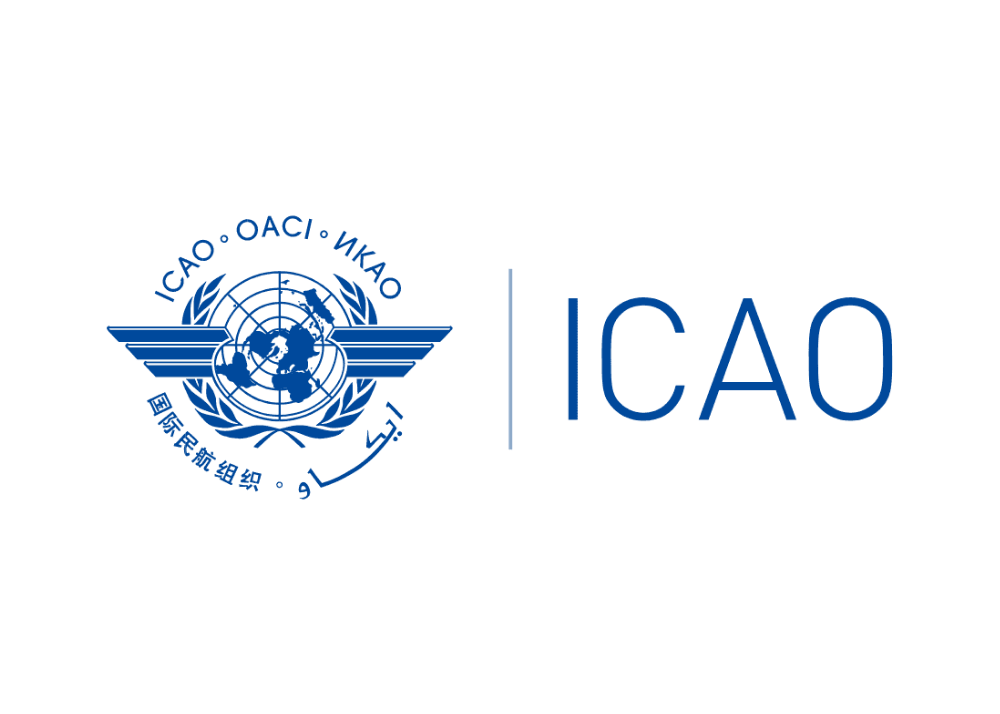Photometric characteristics and distributions of obstacle lights
Here, for increasing readability, REDDOT reorganizes obstruction lighting’s photometric characteristics by intensity. The criteria of obstruction lights regulated by ICAO remain the same.
| Light Type | Color | Signal type (flash rate) | Peak intensity (cd) at given background luminance | Vertical beam spread | Vertical elevation angle (minimum requirements) | ||||
|---|---|---|---|---|---|---|---|---|---|
| Day (Above 500cd/m2) | Twilight (50- 500cd/m2) | Night (Below 50cd/m2) | |||||||
| Low-intensity, Type A (fixed obstacle) | Red | Fixed | N/A | N/A | ≥10cd | ≥10° | +2° - +10° | ||
| Low-intensity, Type B (fixed obstacle) | Red | Fixed | N/A | N/A | ≥32cd | ≥10° | +2° - +10° | ||
| Low-intensity, Type C (mobile obstacle) | Yellow/Blue | Flashing (60-90fpm) | N/A | ≥40cd | ≥40cd & ≤400cd | ≥12° | +2° - +20° | ||
| Low-intensity, Type D (follow-me obstacle) | Yellow | Flashing (60-90fpm) | N/A | ≥200cd | ≥200cd & ≤400cd | N/A | N/A | ||
| Low-intensity, Type E (fixed obstacle) | Red | Flashing (20-60fpm) | N/A | N/A | ≥32cd | ≥10° | +2° - +10° | ||
| Light Type | Color | Signal type (flash rate) | Peak intensity (cd) at given background luminance | Vertical beam spread (minimum requirements) | Vertical beam spread (recommended requirements) | Intensity at Vertical elevation angle (minimum requirements) | Intensity at Vertical elevation angle (recommended requirements) | ||||||||||
|---|---|---|---|---|---|---|---|---|---|---|---|---|---|---|---|---|---|
| Day (Above 500cd/m2) | Twilight (50- 500cd/m2) | Night (Below 50cd/m2) | 0° | -1° | 0° | -1° | -10° | ||||||||||
| Medium-intensity, Type A | White | Flashing (20-60fpm) | 20,000cd±25% | 2,000cd±25% | 2,000cd±25% | ≥3° | NA | Day: mean: ≥20,000cd, min.: ≥15,000cd;Night: mean: ≥2,000cd, min.: ≥1,500cd; | Day: ≥7,500cd; Night: ≥750cd; | Day: ≤25,000cd; Night: ≤2,500cd | Day: ≤11,250cd; Night: 1,125cd | Day: ≤750cd; Night: ≤75cd | |||||
| Medium-intensity, Type B | Red | Flashing (20-60fpm) | N/A | N/A | 2,000cd±25% | ≥3° | NA | mean: ≥2,000cd, min.: ≥1,500cd; | ≥750cd | ≤2,500cd | ≤1,125cd | ≤75cd | |||||
| Medium-intensity, Type C | Red | Fixed | N/A | N/A | 2,000cd±25% | ≥3° | NA | mean: ≥2,000cd, min.: ≥1,500cd; | ≥750cd | ≤2,500cd | ≤1,125cd | ≤75cd | |||||
| High-intensity, Type A | White | Flashing (40-60fpm) | 200,000cd±25% | 20,000cd±25% | 2,000cd±25% | ≥3° | ≤7° | Day: mean: ≥200,000cd, min.: ≥150,000cd; Twilight: mean: ≥20,000cd, min.: ≥15,000cd; Night: mean: ≥2,000cd, min.: ≥1,500cd; | Day: ≥75,000cd; Twilight: 7,500cd Night: ≥750cd; | Day: ≤250,000cd; Twilight: ≤25,000cd; Night: ≤2,500cd | Day: ≤112,500cd; Twilight: ≤11,250cd; Night: ≤1,125cd | Day: ≤7,500cd; Twilight: ≤750cd; Night: ≤75cd | |||||
| High-intensity, Type B | White | Flashing (40-60fpm) | 100,000cd±25% | 20,000cd±25% | 2,000cd±25% | ≥3° | ≤7° | Day: mean: ≥100,000cd, min.: ≥75,000cd; Twilight: mean: ≥20,000cd, min.: ≥15,000cd; Night: mean: ≥2,000cd, min.: ≥1,500cd; | Day: ≥37,500cd; Twilight: 7,500cd Night: ≥750cd; | Day: ≤125,000cd; Twilight: ≤25,000cd; Night: ≤2,500cd | Day: ≤56,250cd; Twilight: ≤11,250cd; Night: ≤1,125cd | Day: ≤3,750cd; Twilight: ≤750cd; Night: ≤75cd | |||||
Obstruction Lighting for fixed objects (expect wind turbines, overhead wires, cables, etc., and supporting towers)
Lighting (General Principles)
6.2.3.10 In the case of an object to be lighted, one or more low-, medium- or high-intensity obstacle lights shall be located as close as practicable to the top of the object.
Note.— Recommendations on how a combination of low-, medium- and/or high-intensity lights on obstacles should be displayed are given in Appendix 5.
6.2.3.11 Recommendation.— In the case of chimney or other structure of like function, the top lights should be placed sufficiently below the top so as to minimize contamination by smoke, etc. (See Figure 6-2).
6.2.3.12 In the case of a tower or antenna structure indicated by high-intensity obstacle lights by day with an appurtenance, such as a rod or an antenna, greater than 12 m where it is not practicable to locate a high-intensity obstacle light on the top of the appurtenance, such a light shall be located at the highest practicable point and, if practicable, a medium-intensity obstacle light, Type A, mounted on the top.
6.2.3.13 In the case of an extensive object or of a group of closely spaced objects to be lighted that are:
a) penetrating a horizontal obstacle limitation surface (OLS) or located outside an OLS. the top lights shall be so arranged as to at least indicate the points or edges of the object highest in relation to the obstacle limitation surface or above the ground, and so as to indicate the general definition and the extent of the objects; and
b) penetrating a sloping OLS. the top lights shall be so arranged as to at least indicate the points or edges of the object highest in relation to the OLS, and so as to indicate the general definition and the extent of the objects. If two or more edges are of the same height, the edge nearest the landing area shall be marked.
6.2.3.14 Recommendation.— When the obstacle limitation surface concerned is sloping and the highest point above the OLS is not the highest point of the object, additional obstacle lights should be placed on the highest point of the object.
6.2.3.15 Where lights are applied to display the general definition of an extensive object or a group of closely spaced objects, and
a) low-intensity lights are used, they shall be spaced at longitudinal intervals not exceeding 45 m; and
b) medium-intensity lights are used, they shall be spaced at longitudinal intervals not exceeding 900 m.
6.2.3.16 High-intensity obstacle lights. Type A. and medium-intensity obstacle lights. Types A and B, located on an object shall flash simultaneously.
6.2.3.17 Recommendation.— The installation setting angles for high-intensity obstacle lights, Type A, should be in accordance with Table 6-5.
Note.— High-in tensity obstacle lights are intended for day use as well as night use. Care is needed to ensure that these lights do not create disconcerting dazzle. Guidance on the design, location and operation of high-intensity obstacle lights is given in the Aerodrome Design Manual (Doc 9157), Part 4.
6.2.3.18 Recommendation.— Where, in the opinion of the appropriate authority, the use of high-intensity obstacle lights, Type A, or medium-intensity obstacle lights, Type A, at night may dazzle pilots in the vicinity of an aerodrome (within approximately 10 000 m radius) or cause significant environmental concerns, a dual obstacle lighting system should be provided. This system should be composed of high-intensity obstacle lights, Type A, or medium-intensity obstacle lights, Type A, as appropriate, for daytime and twilight use and medium-intensity obstacle lights, Type B or C, for night-time use.
Lighting of objects with a height less than 45 in above ground level
6.2.3.19 Recommendation.— Low-intensity obstacle lights, Type A or B, should be used where the object is a less extensive one and its height above the surrounding ground is less than 45 m.
6.2.3.20 Recommendation.— Where the use of low-intensity obstacle lights, Type A or B, would be inadequate or an early special warning is required, then medium- or high-intensity obstacle lights should be used.
6.2.3.21 Recommendation.— Low-intensity obstacle lights, Type B, should be used either alone or in combination with medium-intensity obstacle lights, Type B, in accordance with 6.2.3.22.
6.2.3.22 Recommendation.— Medium-intensity obstacle lights, Type A, B or C, should be used where the object is an extensive one. Medium-intensity obstacle lights, Types A and C, should be used alone, whereas medium-intensity obstacle lights, Type B, should be used either alone or in combination with low-intensity obstacle lights, Type B.
Note.—A group of buildings is regarded as an extensive object.
Lighting of objects with a height 45 in to a height less than 150 m above ground level
6.2.3.23 Recommendation.— Medium-intensity obstacle lights, Type A, B or C, should be used. Medium-intensity obstacle lights, Types A and C, should be used alone, whereas medium-intensity obstacle lights, Type B, should be used either alone or in combination with low-intensity obstacle lights, Type B.
6.2.3.24 Where an object is indicated by medium-intensity obstacle lights, Type A, and the top of the object is more than 105 m above the level of the surrounding ground or the elevation of tops of nearby buildings (when the object to be marked is surrounded by buildings), additional lights shall be provided at intermediate levels. These additional intermediate lights shall be spaced as equally as practicable, between the top lights and ground level or the level of tops of nearby buildings, as appropriate, with the spacing not exceeding 105 m.
6.2.3.25 Where an object is indicated by medium-intensity obstacle lights, Type B, and the top of the object is more than 45 m above the level of the surrounding ground or the elevation of tops of nearby buildings (when the object to be marked is surrounded by buildings), additional lights shall be provided at intermediate levels. These additional intermediate lights shall be alternately low-intensity obstacle lights, Type B, and medium-intensity obstacle lights, Type B, and shall be spaced as equally as practicable between the top lights and ground level or the level of tops of nearby buildings, as appropriate, with the spacing not exceeding 52 m.
6.2.3.26 Where an object is indicated by medium-intensity obstacle lights, Type C, and the top of the object is more than 45 m above the level of the surrounding ground or the elevation of tops of nearby buildings (when the object to be marked is surrounded by buildings), additional lights shall be provided at intermediate levels. These additional intermediate lights shall be spaced as equally as practicable, between the top lights and ground level or the level of tops of nearby buildings, as appropriate, with the spacing not exceeding 52 m.
6.2.3.27 Where high-intensity obstacle lights, Type A, are used, they shall be spaced at uniform intervals not exceeding 105 m between the ground level and the top light(s) specified in 6.2.3.10, except that where an object to be marked is surrounded by buildings, the elevation of the tops of the buildings may be used as the equivalent of the ground level when determining the number of light levels.
Lighting of objects with a height 150 m or more above ground level
6.2.3.28 Recommendation.— High-intensity obstacle lights, Type A, should be used to indicate the presence of an object if its height above the level of the surrounding ground exceeds 150 m and an aeronautical study indicates such lights to be essential for the recognition of the object by day.
6.2.3.29 Where high-intensity obstacle lights. Type A. are used, they shall be spaced at uniform intervals not exceeding 105 m between the ground level and the top light(s) specified in 6.2.3.10. except that where an object to be marked is surrounded by buildings, the elevation of the tops of the buildings may be used as the equivalent of the ground level when determining the number of light levels.
6.2.3.30 Recommendation.— Where, in the opinion of the appropriate authority, the use of high-intensity obstacle lights, Type A, at night may dazzle pilots in the vicinity of an aerodrome (within approximately 10 000 m radius) or cause significant environmental concerns, medium-intensity obstacle lights, Type C, should be used alone, whereas medium- intensity obstacle lights, Type B, should be used either alone or in combination with low-intensity obstacle lights, Type B.
6.2.3.31 Where an object is mdicated by medium-intensity obstacle lights, Type A, additional lights shall be provided at intermediate levels. These additional intermediate lights shall be spaced as equally as practicable, between the top lights and ground level or the level of tops of nearby buildings, as appropriate, with the spacing not exceeding 105 m.
6.2.3.32 Where an object is indicated by medium-intensity obstacle lights, Type B, additional lights shall be provided at intermediate levels. These additional intermediate lights shall be alternately low-intensity obstacle lights. Type B. and medium-intensity obstacle lights. Type B. and shall be spaced as equally as practicable between the top lights and ground level or the level of tops of nearby buildings, as appropriate, with the spacing not exceeding 52 m.
6.2.3.33 Where an object is indicated by medium-intensity obstacle lights, Type C, additional lights shall be provided at intermediate levels. These additional intermediate lights shall be spaced as equally as practicable, between the top lights and ground level or the level of tops of nearby buildings, as appropriate, with the spacing not exceeding 52 m.
Marking / Obstruction Lighting for wind turbines
6.2.4 Wind turbines
6.2.4.1 A wind turbine shall be marked and/or lighted if it is determined to be an obstacle.
Note 1.— Additional lighting or markings may be provided where in the opinion of the state such lighting or markings are deemed necessary.
Markings for wind turbines
6.2.4.2 Recommendation.— The rotor blades, nacelle and upper 2/3 of the supporting mast of wind turbines should be painted white, unless otherwise indicated by an aeronautical study.
Obstruction Lighting for wind turbines
6.2.4.3 Recommendation.— When lighting is deemed necessary, in the case of a wind farm, i.e. a group of two or more wind turbines, the wind farm should be regarded as an extensive object and the lights should be installed:
a) to identify the perimeter of the wind farm;
b) respecting the maximum spacing, in accordance with 6.2.3.15, between the lights along the perimeter, unless a dedicated assessment shows that a greater spacing can be used;
c) so that, where fashing lights are used, they flash simultaneously throughout the wind farm;
d) so that, within a wind farm, any wind turbines of significantly higher ele\’ation are also identified wherever they are located; and
e) at locations prescribed in a), b) and d), respecting the following criteria:
- for wind turbines of less than 150 m in overall height (hub height plus vertical blade height), medium-intensity lighting on the nacelle should be provided;
- for wind turbines from 150 m to 315 m in overall height, in addition to the medium-intensity light installed on the nacelle, a second light serving as an alternate should be provided in case of failure of the operating light The lights should be installed to assure that the output of either light is not blocked by the other; and
- in addition, for wind turbines from 150 m to 315 m in overall height, an intermediate level at half the nacelle height of at least three low-intensity Type E lights, as specified in 6.2.1.3, should be provided. If an aeronautical study shows that low-intensity Type E lights are not suitable, low-intensity Type A or B lights may be used.
Note.— The above 6.2.4.3 e) does not address wind turbines of more than 315 m of overall height. For such wind turbines, additional marking and lighting may be required as determined by an aeronautical study.
6.2.4.4 Recommendation.— The obstacle lights should be installed on the nacelle in such a manner as to provide an unobstructed view for aircraft approaching from any direction.
6.2.4.5 Recommendation.— Where lighting is deemed necessary for a single wind turbine or short line of wind turbines, the installation should be in accordance with 6.2.4.3 e) or as determined by an aeronautical study.
Marking Obstruction Lighting for overhead wires, cables, etc., and supporting towers
6.2.5 Overhead wires, cables, etc., and supporting towers
Marking
6.2.5.1 Recommendation.— The wires, cables, etc., to be marked should be equipped with markers; the supporting tower should be coloured.
Marking by colours
6.2.5.2. Recommendation.— The supporting towers of overhead wires, cables, etc., that require marking should be marked in accordance with 6.2.3.1 to 6.2.3.4, except that the marking of the supporting towers may be omitted when they are lighted by high-intensity obstacle lights by day.
Marking by markers
6.2.5.3. Markers displayed on or adjacent to objects shall be located in conspicuous positions so as to retain the general definition of the object and shall be recognizable in clear weather from a distance of at least 1 000 m for an object to be viewed from the air and 300 m for an object to be viewed from the ground in all directions in which an aircraft is likely to approach the object. The shape of markers shall be distinctive to the extent necessary to ensure that they are not mistaken for markers employed to convey other information, and they shall be such that the hazard presented by the object they mark is not increased.
6.2.5.4. Recommendation.— A marker displayed on an overhead wire, cable, etc., should be spherical and have a diameter of not less than 60 cm.
6.2.5.5. Recommendation.— The spacing between two consecutive markers or between a marker and a supporting tower should be appropriate to the diameter of the marker, but in no case should the spacing exceed:
- 30 m where the marker diameter is 60 cm progressively increasing with the diameter of the marker to
- 35 m where the marker diameter is 80 cm and further progressively increasing to a maximum of
- 40 m where the marker diameter is of at least 130 cm.
Where multiple wires, cables, etc., are involved, a marker should be located not lower than the level of the highest wire at the point marked.
6.2.5.6. Recommendation.— A marker should be of one colour. When installed, white and red, or white and orange markers should be displayed alternately. The colour selected should contrast with the background against which it will be seen.
6.2.5.7. Recommendation.— When it has been determined that an overhead wire, cable, etc., needs to be marked but it is not practicable to install markers on the wire, cable, etc., then high-intensity obstacle lights, Type B, should be provided on their supporting towers.
Lighting
6.2.5.8. Recommendation.— High-intensity obstacle lights, Type B, should be used to indicate the presence of a tower supporting overhead wires, cables, etc., where:
- an aeronautical study indicates such lights to be essential for the recognition of the presence of wires, cables, etc.; or
- it has not been found practicable to install markers on the wires, cables, etc.
6.2.5.9 Where high-intensity obstacle lights. Type B. are used, they shall be located at three levels:
- at the top of the tower;
- at the lowest level of the catenary of the wires or cables: and
- at approximately midway between these two levels.
Note.— In some cases, this may require locating the lights off the tower.
6.2.5.10 Recommendation.— High-intensity obstacle lights, Type B, indicating the presence of a tower supporting overhead wires, cables, etc., should flash sequentially; first the middle light, second the top light and last, the bottom light. The intervals between flashes of the lights should approximate the following ratios:
| Flash interval between | Ratio of cycle time |
|---|---|
| middle and top light | 1/13 |
| top and bottom light | 2/13 |
| bottom and top light | 10/13 |
Note.— High-intensity obstacle lights are intended for day use as well as night use. Care is needed to ensure that these lights do not create disconcerting dazzle. Guidance on the design, operation and the location of high-in tensity obstacle lights is given in the Aerodrome Design Manual (Doc 9157), Part 4.
6.2.5.11 Recommendation.— Where, in the opinion of the appropriate authority, the use of high-intensity obstacle lights, Type B, at night may dazzle pilots in the vicinity of an aerodrome (within approximately 10 000 m radius) or cause significant environmental concerns, a dual obstacle lighting system should be provided. This system should be composed of high-intensity obstacle lights, Type B, for daytime and twilight use and medium-intensity obstacle lights, Type B, for nighttime use. Where medium-intensity lights are used they should be installed at the same level as the high-intensity obstacle light Type B.
6.2.5.12 Recommendation.— The installation setting angles for high-intensity obstacle lights, Type B, should be in accordance with Table 6-5.
| Height of light unit above terrain (AGL) | Angle of the peak of the beam above the horizontal | |
|---|---|---|
| Greater than | Not exceeding | |
| 151m | 0° | |
| 122m | 151m | 1° |
| 92m | 122m | 2° |
| 92m | 3° |
Appendix 5
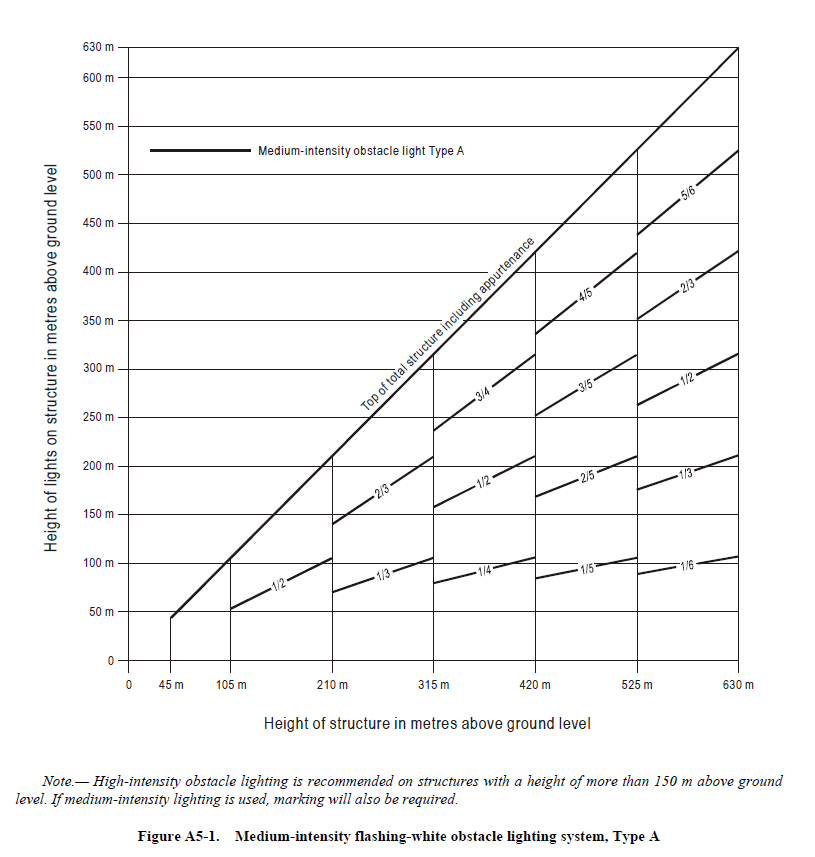
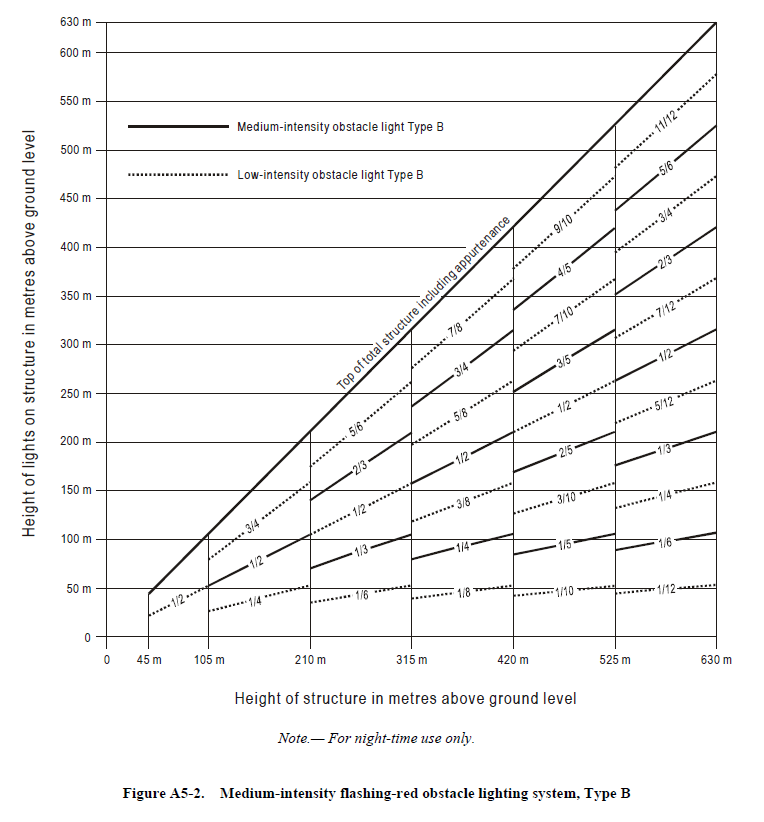
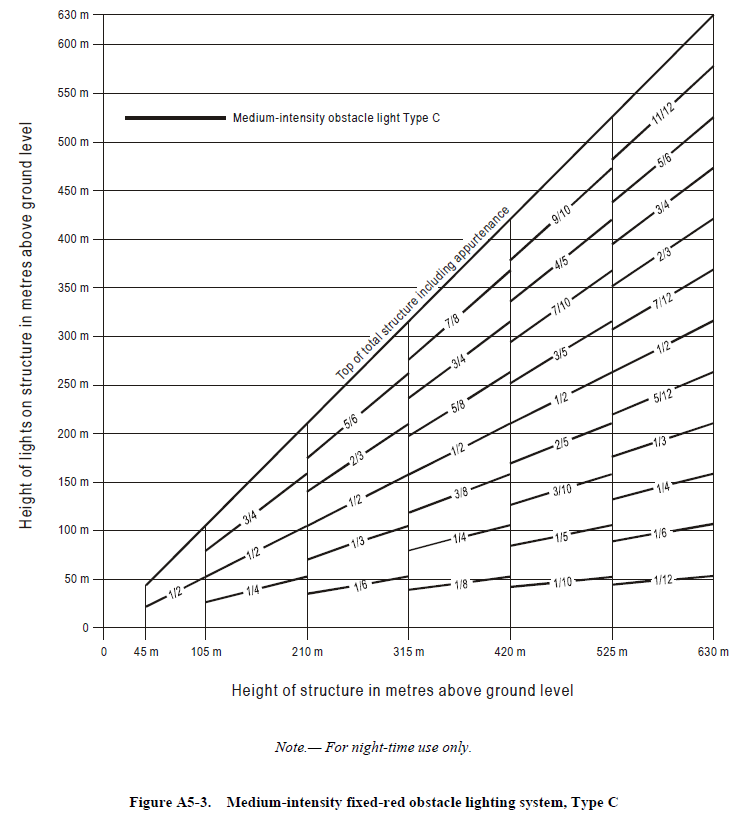
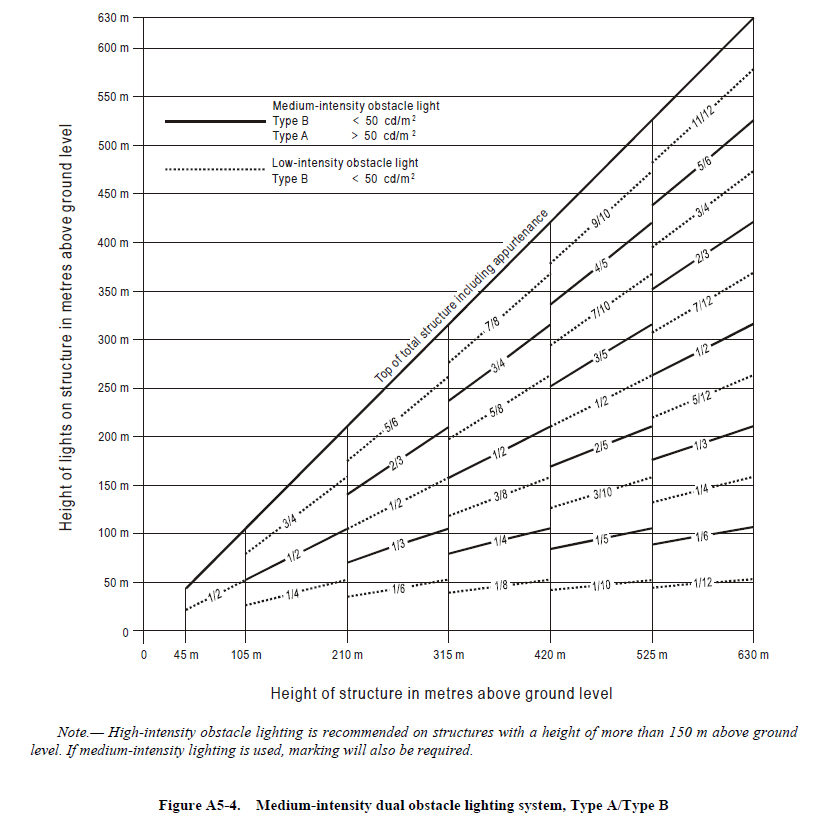
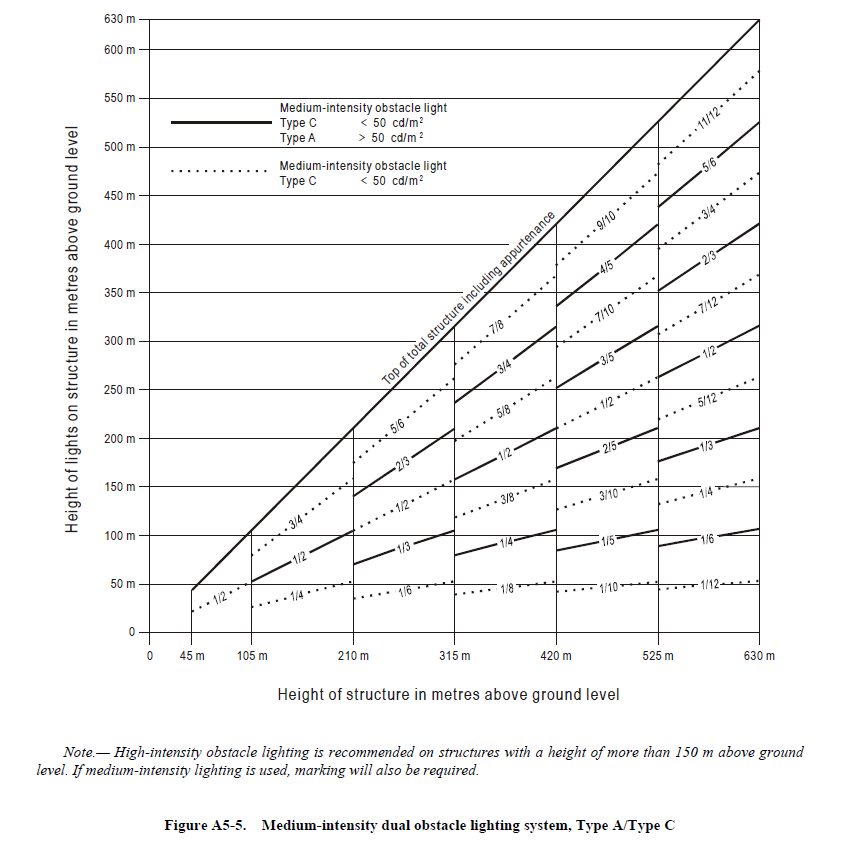
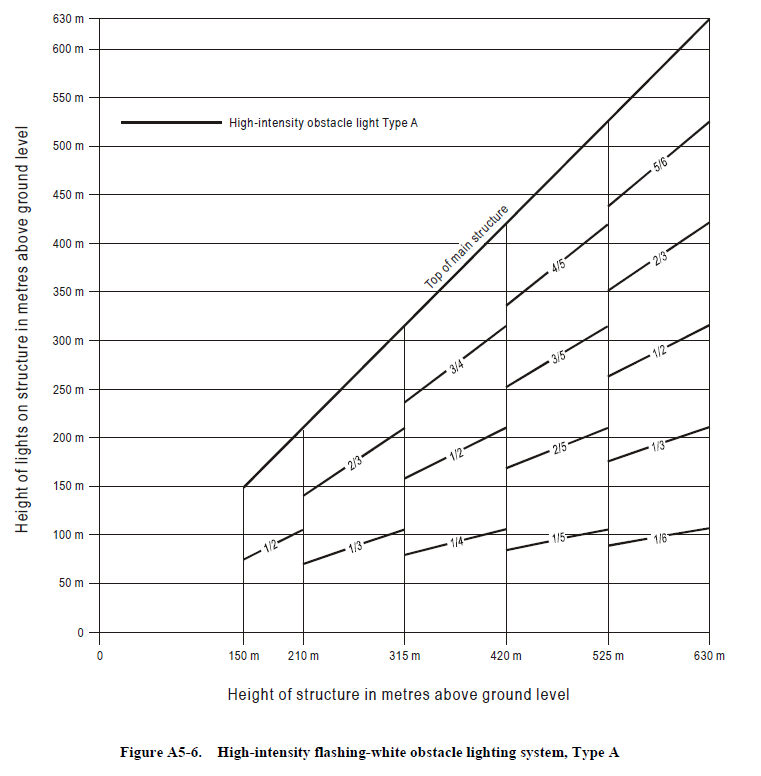
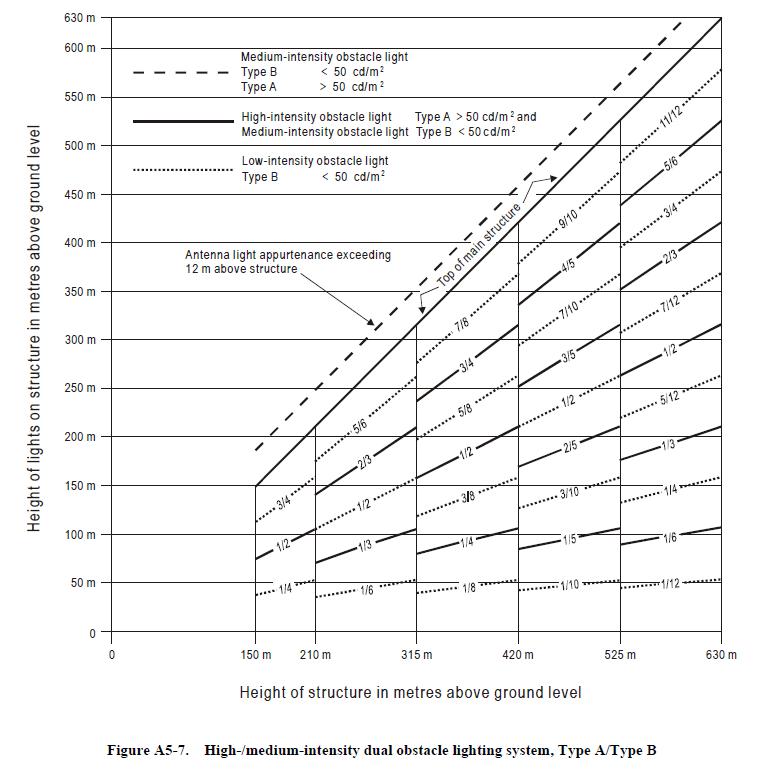
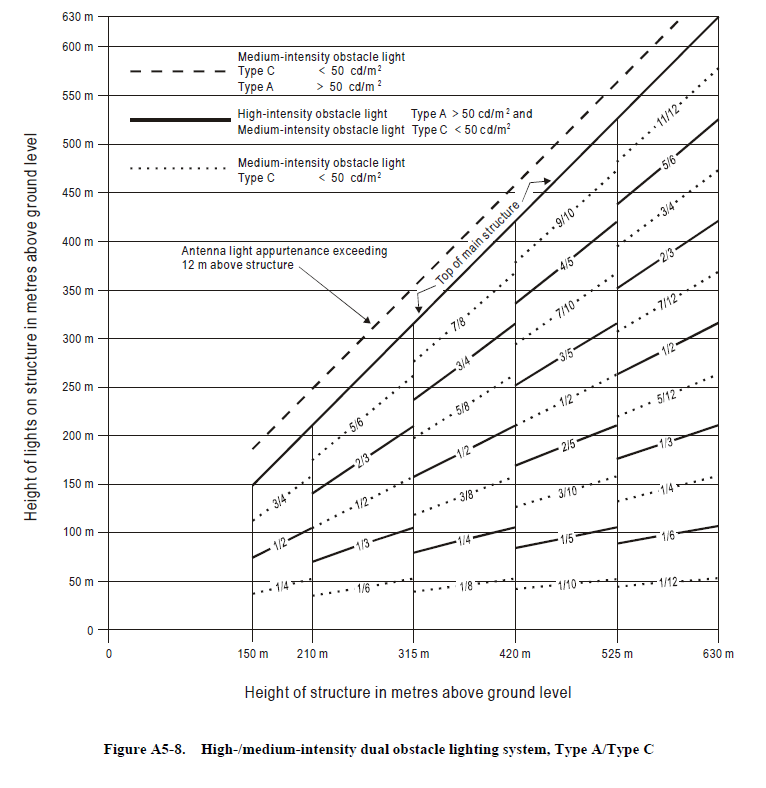
Reference
Aerodromes, V.I., 2018. Aerodrome design and operations, Annex 14 to the convention on International Civil Aviation. International Civil Aviation Organisation.

